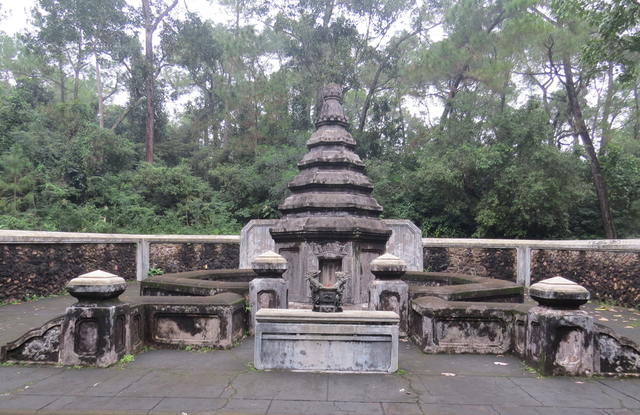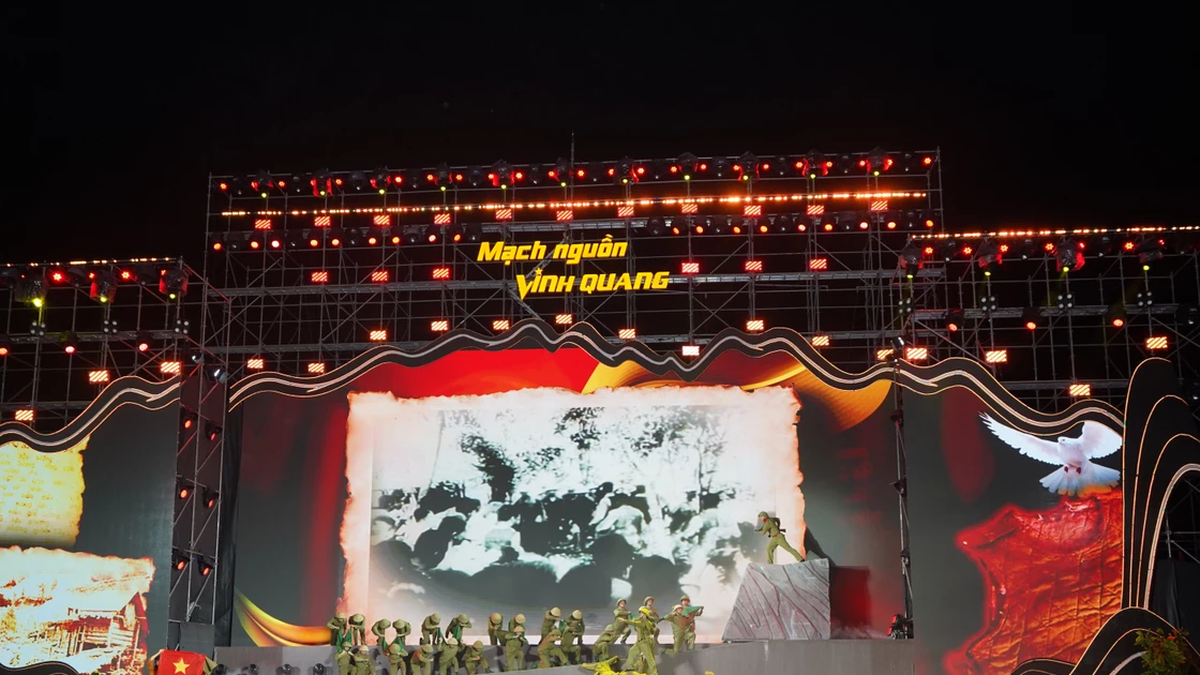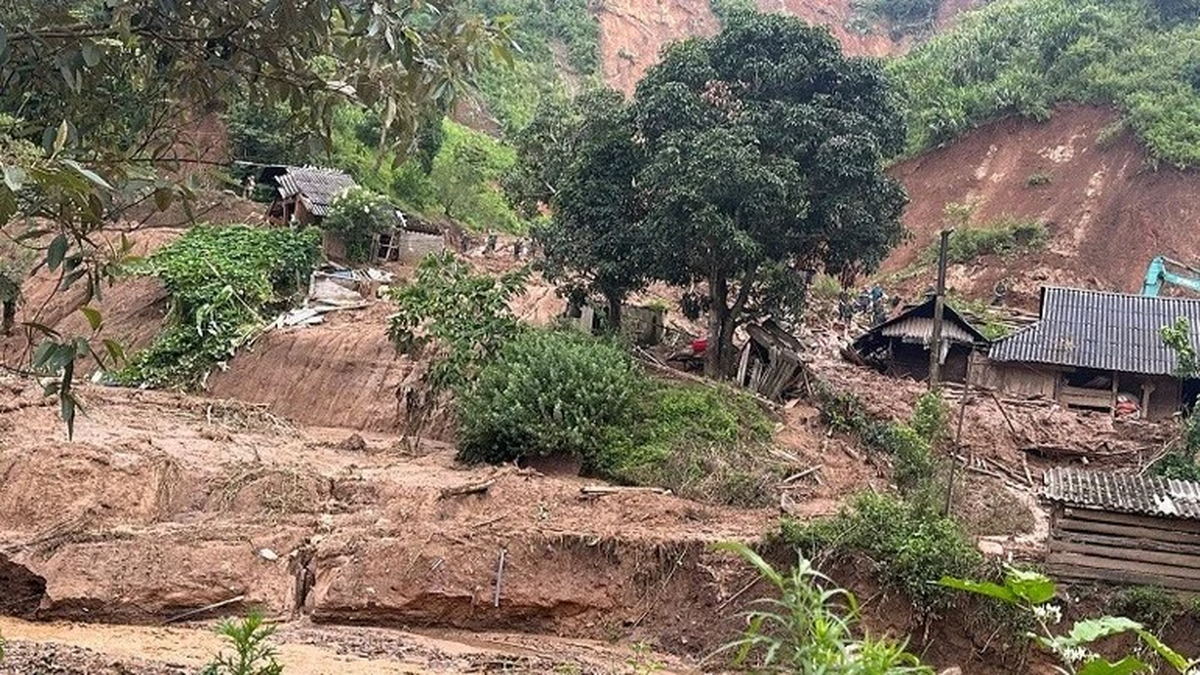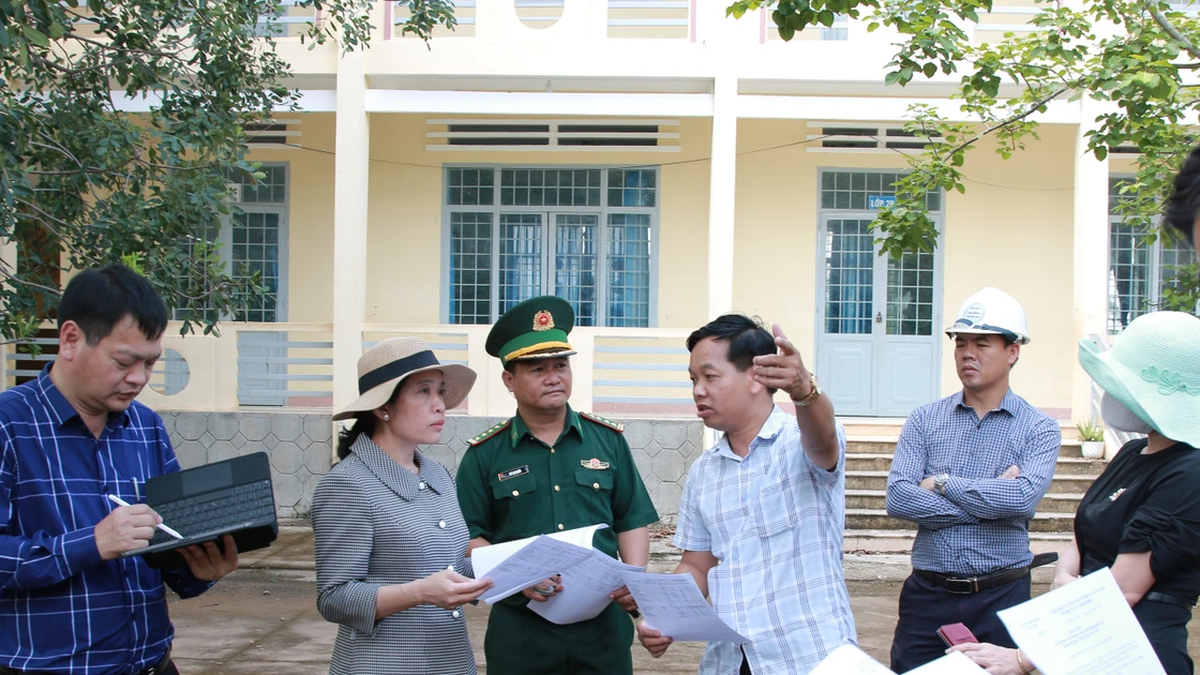YIN-YANG BALANCE TECHNIQUE
Dr. Phan Thanh Hai said that, according to the principle of the five elements, the system of temples, pagodas and pagodas is mainly arranged in the west of the capital, both inside and outside. Outside, above is the Hon Chen Temple, below is the Khai Thanh Tu (worshiping Confucius' father), the Temple of Literature, the Temple of Martial Arts, the Thien Mu Pagoda, the Trung Hung Cong Than Temple... Inside the capital, in the west is the Xa Tac Altar, the Do Thanh Hoang Temple, the Am Hon Altar... That is, the underworld exists parallel to the world of the living. For the capitals of China and Vietnam in history, planning the mausoleum area for kings has always been an extremely important issue.

Lieu Quan ancestral tower, at the foot of Thien Thai mountain where Thien Ton ancestral temple is located (on Thien Thai mountain, now in Ngu Tay village, An Tay ward, Hue city)
BNL
For the capital Hue, the planning and construction of the royal mausoleum system in the western and southwestern areas, upstream of the Perfume River, has created a special, unique and almost unique urban model among the urban - capitals of the monarchy. It is a harmonious urban model, balancing yin and yang, in which the yang part in the east is the citadel, town; the yin part is the mausoleum area, temples in the west, southwest. The Perfume River is the soft axis, the road connecting these two parts.
King Gia Long spent a lot of time and effort choosing a mausoleum for him and his family. The person who found this land was Le Duy Thanh (son of scholar Le Quy Don). Thien Tho mausoleum is the area that the first emperor of the dynasty prepared for his entire family, an area of 2,875 hectares, with all the elements of a "ten thousand years of good fortune" land. From the name to the layout, Thien Tho mausoleum has many similarities with the Thirteen Tombs of the Ming Dynasty in Beijing, China.
King Minh Mang wanted to change. To find a satisfactory "ten thousand years of good fortune" land at the foot of Hieu Son mountain, it took him 14 years (1826 - 1840). But in return, King Minh Mang's tomb with a total area of over 500 hectares on the left side of Bang Lang intersection is a beautiful land in terms of feng shui and landscape. More importantly, he opened a new direction for planning the tombs of later kings. King Tu Duc chose the land for his father (Thieu Tri tomb - Xuong tomb) and himself (Khiem tomb) according to King Minh Mang's perspective.
Therefore, the tombs of the Nguyen Dynasty emperors, especially the tombs of the first four kings of the dynasty (Thien Tho Lang, Hieu Lang, Xuong Lang, Khiem Lang) are all works of special value in many aspects, in which the most prominent is the value of feng shui landscape.
TRAN SON PAGODAS
Along with the system of temples and mausoleums in the southwest of Hue citadel, there are also special ancestral pagodas located in prime locations. The Nguyen lords sent people to China to invite highly virtuous monks to come and restore the foundation.
Right at the foot of Hon Thieng (Mount Ban) in Thuan Hoa, around 1682 - 1684, Zen master Nguyen Thieu, also known as Hoan Bich Nguyen Thieu, of the 33rd generation of the Lam Te Zen sect from Trieu Chau (Guangdong, China) also came to Dai Viet to propagate the Dharma, establishing the Quoc An ancestral temple.
Around 1690, Zen master Tu Dung, a high-ranking monk from Guangdong (China) belonging to the 34th generation of the Lam Te sect, also came to Vietnam to spread Buddhism. He established a bamboo and leaf hermitage on Hoang Long mountain, Thuan Hoa province. Later, the hermitage was transformed into a pagoda and named An Ton pagoda (or Tong, today's Tu Dam pagoda), with the meaning of "taking the transmission of the mind as the main principle".
Right on the mountain considered the head of the sacred dragon, Lord Nguyen invited monk Giac Phong from China to re-establish the mountain (around 1693 - 1714) and named it Ham Long Pagoda (now Bao Quoc Pagoda). After building the pagoda, right at the foot of the mountain was dug a very clear and sweet well (Ham Long Tinh).
Legend of the Zen sect in Hue tells that during the time when the Nguyen Lords went to the South to establish their career, they settled in Thuan Hoa to realize their dream of establishing a nation and pacifying the people according to the prophecy of Lady of Heaven (Linh Mu). Late at night, people often saw a big dragon appear in the sky, causing wind and rain, disturbing the people. In the palace, the court was in chaos.
The lords then sought out people who were knowledgeable in geography to investigate and found out that right in front of the capital city of Phu Xuan, there was a sacred mountain range shaped like a dragon with many dragon veins that restrained the imperial power. It needed a high-ranking person to guard and subdue the bad omen. From then on, the lords allowed highly virtuous Zen masters to stick their staffs into the graves to tame the sacred dragon and force it to pay homage to the Emperor of Heaven. Indeed, the sacred dragon no longer caused trouble. Therefore, this mountainous area was named Binh An Son.
These pagodas are all located on the Binh An Son range, which is the dragon vein position on the sacred dragon's back. And strangely enough, this landscape named Binh An Son gave birth to the second Vietnamese Zen sect, after the Truc Lam Yen Tu Zen sect, which is the Lieu Quan Zen sect. This Vietnamese Zen sect was founded by the founder Lieu Quan, whose family name was Le, whose name was Thiet Dieu (born in the year of the Goat, 1667 - passed away in 1742), from Bach Ma village, now Song Cau town, Phu Yen province). He went to Thuan Hoa to study Buddhism and was certified by the founder Minh Hoang Tu Dung (Tu Dam temple) and later founded the Lieu Quan Zen sect, originating from the Thien Ton temple (on Thien Thai mountain, now Ngu Tay village, An Tay ward, Hue city).
The remarkable point related to feng shui is that if the land north of the Perfume River is associated with the Hue Capital with the 13-king dynasty, which established the Imperial system to pass on the throne, then the other side of the Perfume River has become the Buddhist capital with the Lieu Quan Zen sect with the Dharma verses passed down. These two streams of the secular and the religious have formed the characteristics of the quiet Hue culture until today.
Source: https://thanhnien.vn/phong-thuy-kinh-thanh-hue-khac-che-long-mach-vung-tay-nam-song-huong-185230825131051167.htm


































































































Comment (0)